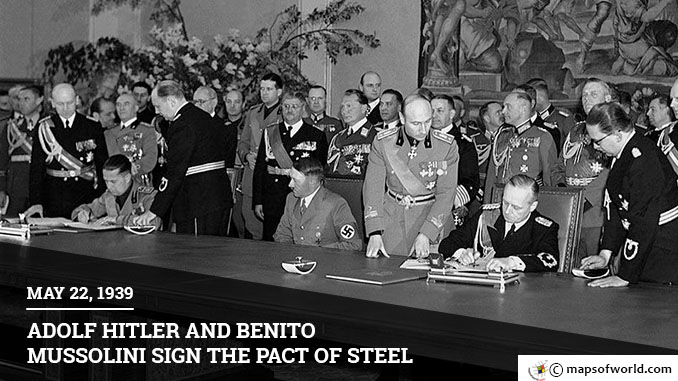On May 22, 1939, Benito Mussolini and Adolf Hitler signed the military and political alliance, on behalf of Italy and Germany, popularly called the Pact of Steel (Stahlpakt in German and Patto d’Acciaio in Italian). The term ‘Pact of Steel’ was Mussolini’s creation. The two had first considered ‘Pact of Blood’ to describe this historic agreement. The Duce, however, thought that this might not be well received back home. He also coined term Axis powers to the two parties signing the Pact of Steel. The Axis powers would ultimately come to include Japan during the World War II. With the end of World War I, the Allied nations, with the U.S., the U.K., France, and Russia had gained much political and military clout. The aftermath of the Treaty of Versailles had further punished Germany economically and the harsh terms were found oppressive by Germany. While Hitler’s rise was alarming in the larger context, the Führer was determined to strengthen Germany by forging strong alliances and by embarking on active and aggressive rearmament. Meanwhile, in Italy, the rise of the Fascist regime under the leadership of Mussolini provided Hitler just the right opportunity he needed. To the East, Japan was alarmed by the rise of a dominant Soviet Union. The various political developments in Europe and the East through the course of the two decades following the 1919 Treaty of Versailles drew Japan, Italy, and Germany in a close bond. The Pact of Steel, formally known as the Pact of Friendship and Alliance between Germany and Italy, was originally intended to be a tripartite alliance. Japan, Italy, and, Germany were to sign it but the three had started to disagree over the focus of its terms. While Japan’s focus was its immediate rival from Asia, a growing dynamic, the Soviet Union, the European nations, quite predictably wanted to focus on Britain and France, the potential adversaries. Italy and Germany had historically shared close ties, having been parties to the pre-World War I Triple Alliance. While Italy had then deflected to join the Allies, a Fascist Italy was willing to back the emerging Germany led by Hitler. By September 1940, Japan had also entered the pact as originally intended, clearly chalking out the theaters of action for the next five years and clearly defining the military alliances that would prove to be difficult to break. On May 22, 1939, the pact was signed by the foreign ministers of Germany and Italy with Count Galeazzo Ciano witnessing for Italy and Joachim von Ribbentrop and for Germany. The Pact had two sections: the first section was a declaration of mutual trust and cooperation between Germany and Italy and was an internationally known pact; the second section was a Secret Supplementary Protocol which defined a unification of the economic and military policies of the two nations. This second section did not go well with many members of the Italian government, including Ciano. For Mussolini this pact came not only as a defensive alliance but also a promise of protection for his Balkan adventures. It must be said that the treaty did not bring about the trust and harmony envisioned by Hitler and Mussolini. Both nations remained fearful and distrustful of each other and could not truly act in unison. Also On This Day: 1859 – Sir Arthur Canon Doyle is born in Edinburgh. 1972 – Ceylon adopts a new constitution to become Sri Lanka. 1981 -The Yorkshire Ripper is jailed for life.
May 22 1939 – Adolf Hitler and Benito Mussolini Sign the Pact of Steel
On May 22, 1939, Benito Mussolini and Adolf Hitler signed the military and political alliance, on behalf of Italy and Germany, popularly called the Pact of Steel (Stahlpakt in German…
600
